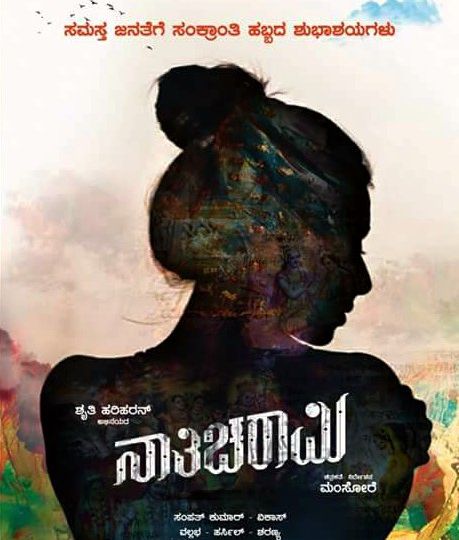
The 2018 Kannada-language film Nathicharami (roughly translated to “I promise to stand by”), directed by Mansore, tells the story of Gowri (Sruthi Hariharan), an urban middle-class IT professional living in Bangalore who lost her husband, Mahesh, three years ago. The film is an examination of Gowri’s sexual desires, society’s absolute clamping down on their existence, and her struggle with coming to terms with and fulfilling her sexuality amidst this judgmental milieu. We follow Gowri’s journey from her first conflicted (and failed) forays into casual sex with Abhimanyu, a man she meets off a dating app, to her friendship with Suresh, a married man in her neighbourhood. Mansore keenly explores the sexuality of men and women, stepping away from the conventionally accepted notions of how these genders are supposed to behave when it comes to sex, and brings in characters which span diverse economic backgrounds (and in a couple of instances, caste) to paint a rich, cross-sectional portrait with sexuality as its main theme
One thing that I have realised during each of my recent, tentative, and much-too-sporadic forays into regional Indian cinema is how far away it is from the glitzy, glamorous, made-up world of Hindi films that most of us are accustomed to. The protagonists depict people we know or are, not only via story and circumstance, but also by way of their clothes, mannerisms, language, and the general absence of a layer of thickly applied, skin-lightening makeup. Nathicharami is no exception. All the characters – from Gowri, herself, to Jayamma, the domestic worker, and Gowri’s lecherous colleague – are unbelievably real. The film is not given to sensationalism of any kind – there is no Abhimanyu lamenting over the fact that he and Gowri didn’t end up having sex, there is no clichéd shot of Gowri with a smile on her face and wind in her hair, feeling all liberated after having sex. So much is Mansore’s commitment to not sensationalising his film that he even chooses not to exploit the fact that Gowri and Suresh’s households share a domestic worker, a plot point which (as we can all expect) could prove to be very fertile ground for a potential twisting of the plot, which would move focus away from Gowri and her internal landscape and onto a more dramatic chain of events. Mansore, however, does nothing that would take away from the significance of the moment when Gowri finally has sex for the first time since her husband died, masterfully using silence to portray the full ambit of her emotions. Gowri’s last appearance on screen has no dialogue – the reconciliation of her sexual desire and her lasting love for her husband, which signifies the end of her struggle to stay true to both her wedding vows and her own sexuality, is brilliantly portrayed by Hariharan only through expression and physicality.
This subtlety of storytelling runs throughout the movie, skilfully using imagery – the photographs of a couple, the arrangement of knickknacks in a home, the flowers Gowri buys everyday – to depict the key motif of Gowri struggling to come to terms with the fact that her sexual desire lives on even after her husband has died. Most of the people around her are representatives of the intensely patriarchal mindset of society vis-à-vis widowhood and female sexuality in general, hence making Gowri’s struggle in the film twofold – of battling both social stigma and her own confused feelings about missing Mahesh and still wanting sex. She has been portrayed from the very start as a woman who expresses her sexual desires (be it to her husband, Abhimanyu, or Suresh), and is aware of the fact that being a husband and a lover can be mutually exclusive things. All talk of sex and desire is promptly shut down by most people around her, and even when Gowri’s mother brings it up, it is to remind her of what she’s missing by not remarrying – essentially, female desire is acknowledged only to uphold existing patriarchal structures. Gowri sharply admonishes her by asking, “How is it right to marry for sex?”, much to the utter horror of her conservative, religious mother. The tension between her sexual desire and society’s impositions drives her to near-frustration – when she gathers the courage to install a dating app, her father-in-law calls her; when she begins to masturbate, she receives a phone call from her mother demanding an answer to a marriage proposal she had received for Gowri.
The acknowledgment, let alone celebration, of female sexuality is seldom portrayed in the kind of popular content I have grown up watching, and continue to watch. And in the rare instances that it is, the celebration is a flamboyant one, more often than not of the kind which is driven by a night of dressing up, partying and alcohol, of the Four More Shots Please! variety. Amidst this cultural milieu, Nathicharami and its brand of celebrating female sexuality is a quiet, almost meditative exercise in understated storytelling. Not that there is anything ‘wrong’ with the former kinds of portrayal of sexuality, of course – everything occupies its own niche in the endeavour to popularise and normalise conversations around this much-tabooed topic. Nathicharami, however, takes sexuality and sexual desire away from upper-class, Gucci-clad women and makes its viewers acknowledge its existence in the lives of women (middle-class wives and widows, in the case of this film) who are invisibilised, both in the society they live in and as subjects of popular content.
Cover Image: IMDb